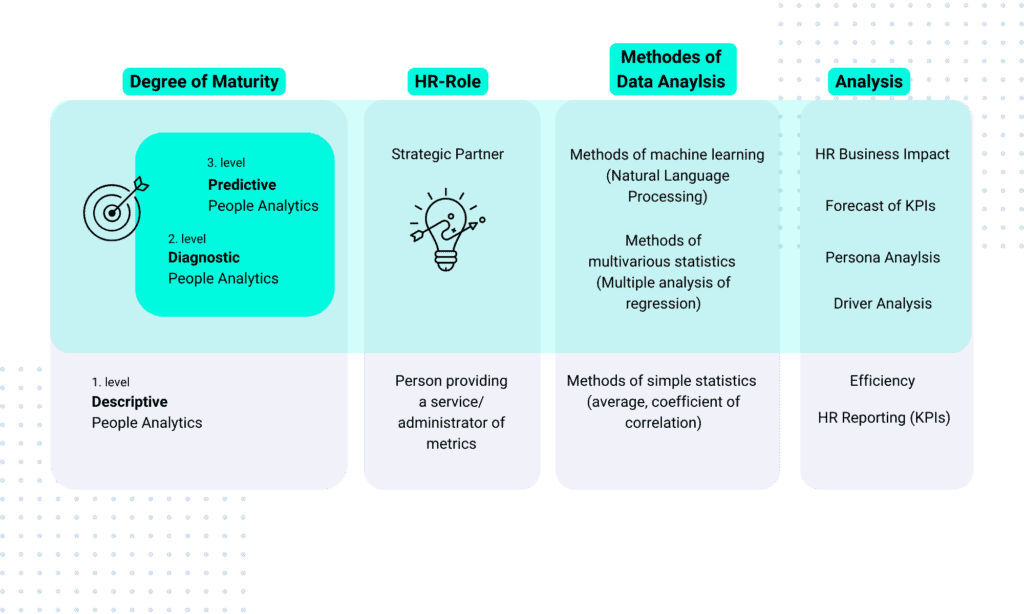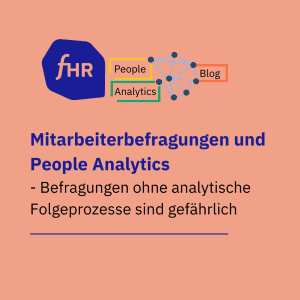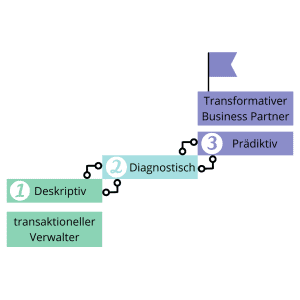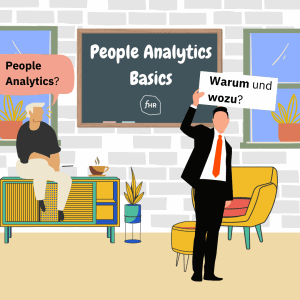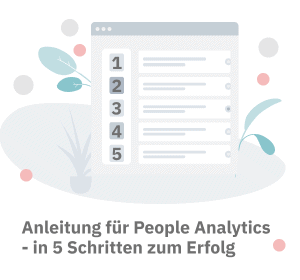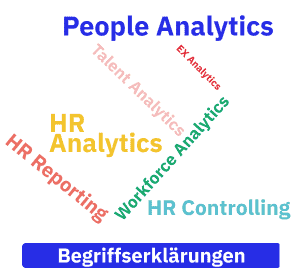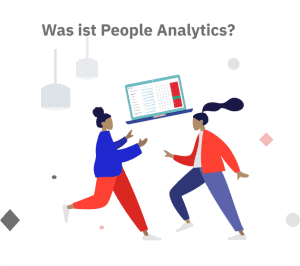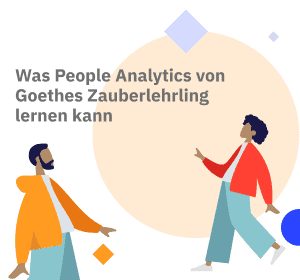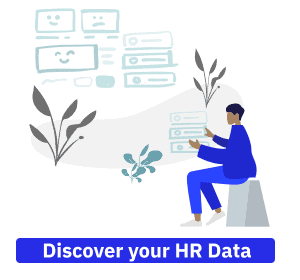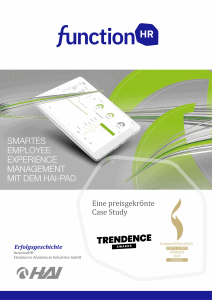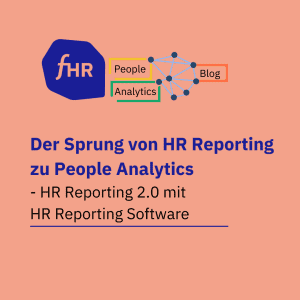
Why People Analytics?
Strategic HR - All about people analytics as a tool for the future of HR

According to David Green, the 2020 global pandemic has elevated the strategic importance of people analytics to a new level of urgency and accuracy for day-to-day operational decisions and longer-term strategic workforce planning. However, real-world experience shows that most organizations are still very far from strategic use and analytics of HR data.
What is people analytics? What data is used? Which analytical methods can be applied? What needs to be taken into account when implementing people analytics projects? How do the analyses of HR data lead to target-oriented follow-up and change processes?
Here we answer these and many other questions about the topic. With valuable tips for the evaluation of data, important information on data protection, – and much more.
Content
Digitalisierung, Big Data und Business Analytics sind nur ein Auszug der Schlagwörter, welche unsere digitalisierte und datenbasierte Arbeitswelt 4.0 prägen werden. Wohingegen in vielen Unternehmensbereichen, wie beispielsweise Finance und Operations datengestützte Prozesse bereits weitgehend etabliert wurden, sind Entscheidungen anhand von systematischen Analysen großer Datenmengen kein Day-to-Day Business im Personalmanagement.
Diesen Status-quo versetzt People Analytics in Bewegung. Der technologische Trend eröffnet die Möglichkeit das Personalmanagement von einer passiven, transaktionellen Rolle zu einem aktiven, strategischen Partner im Unternehmen zu transformieren und damit einen nachhaltigen Paradigmenwechsel einzuleiten.
Definition of People Analytics
According to one common definition, people analytics refers to a human resource management tool that “uses information technology to perform descriptive, visual, and statistical analyses of data on human resource processes, human capital, organizational performance, and external benchmarks to establish […] data-driven decision making” (Marler/Boudreau 2016, p.15).
The chaos of terms can lead to confusion around the topic of HR data analytics. This is because other terms that are often used synonymously with people analytics are: HR Analytics, Talent Analytics, Workforce Analytics, Workforce Intelligence, HR Data Science.
"In our view, People Analytics is not a trend that comes and goes, but a coming (and lasting) reality. The past has repeatedly shown that technologies and methods that can be used in a way that is financially viable and adds economic value will prevail. HR departments that provide real-time data and relevant analysis or analysis capabilities are true 'business partners'."
Weller, 2017
Whitepaper: Einführung in People Analytics
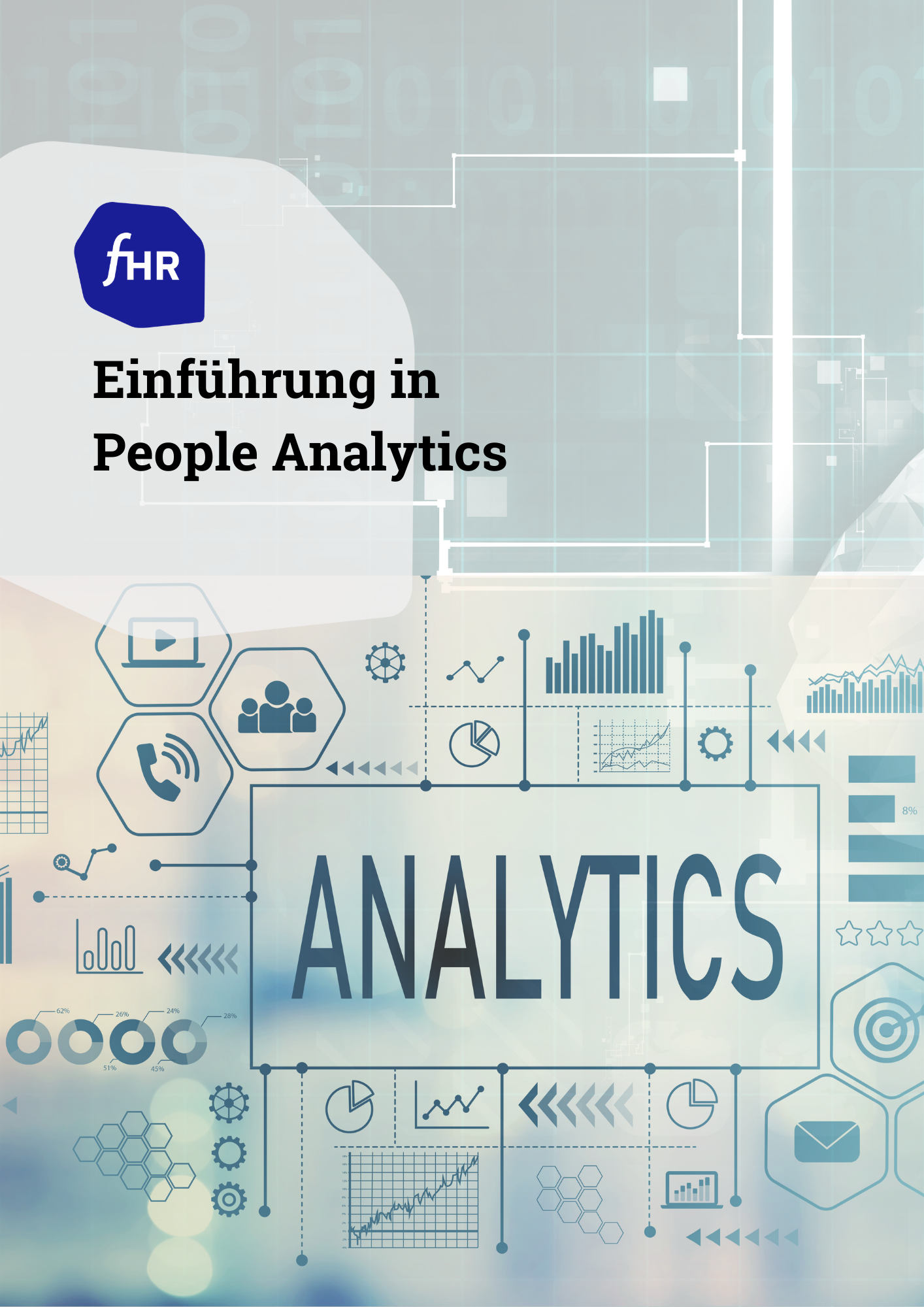
Definition, Zielsetzungen, Datenquellen und Analyseverfahren. Alle Grundlagen für People Analytics auf einen Blick. Dieser Guide hilft Ihnen, die richtigen Fragen für den Einstieg in People Analytics Vorhaben zu stellen und klären!
You are currently viewing a placeholder content from HubSpot. To access the actual content, click the button below. Please note that doing so will share data with third-party providers.
More InformationGoals of People Analytics
People Analytics aims to support people management in the company in a variety of ways – complementing the existing “gut feeling”. Modern data analyses pursue the goal of aligning HR activities with the needs of the company, bringing about improvements and increasing the company’s success.
The focus is on the supporting role of People Analytics for HR professionals. No decisions are made by a machine. Rather, People Analytics aims to provide a data-driven basis for decision-making.
Goals at a glance:
- Tracking of relevant key figures (absenteeism, churn, leadership, feedback, personnel costs)
- Identification of cause and effect relationships in people management
- Evaluation of developments in individual areas of the company
- Support and guidance in change processes
- Forecasts of future developments of the workforce situation in the company
- Monitoring and targeted management of HR processes
The insights gained help to make decisions and processes in HR management more efficient (cost optimization) and more effective (achievement of strategic goals). In this context, the link to the business, i.e. the strategy and the goals of the company, is crucial.
Guidance for People Analytics projects in 5 steps
The successful implementation of a people analytics project is a multi-stage process. In 5 steps, everything from problem definition to data analytics to communicating the results is considered.

The 5 steps for People Analytics projects
- Identify the HR challenge
- Data collection from various sources
- Targeted data analysis
- Derive insights and make them available to relevant stakeholders in a clear and concise manner
- Data-supported derivation of specific actions and initiation of follow-up processes
Industry Insights: The I-CAN-Enable Model as an implementation road map for successful people analytics use cases
Goals | Modules |
|---|---|
|
|

FlixBus
FlixBus was able to overcome the major challenge of employee retention by using data analytics. Within only 6 months, employee retention increased by 50% and the percentage of satisfied employees by 15%. In the meantime, more than 300 managers use the HR Keyboard to support them in their daily work.
Data sources for People Analytics
The concept of Big Data is also important for the HR function. After all, data is the foundation of all analytics. Data from the HR and business context that can be used for people analytics generally falls into four categories:
HR master data and process data are obtained from the company’s internal HR or human resources information systems (HRIS) and are therefore in most cases already available within the company.
Survey data from company-wide employee surveys are collected directly from employees at regular intervals.
Third-party data can be obtained, for example, from social networks such as LinkedIn or employer review portals such as Glassdoor to provide insights into employees’ experiences at the company.
Operational and financial data relates to all other relevant systems, processes and characteristics of the company, for example the company’s performance, and is in most cases already available within the company.
With an intelligent software solution, all these data types can be integrated quickly and easily. This sets the foundation for the strategic use of the data. A prerequisite for this is an understanding of the data landscape and data types as well as data usage.
Data Discovery for People Analytics
Our people analytics experts can help you review the systems and HR data you already have. Find out what specific business problem you can already solve with it.

Types of People Analytics
Industry-leading analytics based on advanced statistics and artificial intelligence generate deep insights into data and the company-specific context. These analyses can be categorized into three levels of maturity.
Descriptive People Analytics
…is very similar to traditional HR controlling. In fact, the first stage of people analytics is similar to today’s HR reporting. With the help of simple statistical methods, questions about the “what?” in the company are answered.
However, the status quo in practice shows that, as a rule, purely descriptive analyses are carried out and evaluated using Excel. Although these evaluations are an integral part of a people analytics strategy, this is just the first step and only creates a limited added value. Don’t worry: making the leap from HR reporting to people analytics is easier than you think.
Diagnostic People Analytics
…on the other hand, aims to look at relationships between important variables (e.g. causes and effects of job satisfaction) and thus asks “Why?” and “How?”. More advanced analytical methods from the fields of machine learning and artificial intelligence are used for this purpose.
In order to really trigger change processes and create a data-driven basis for decision-making, cause-and-effect relationships must be modeled analytically and specific potential for change must be identified. Such a driver analysis would, for example, examine the drivers of employees’ intention to stay. The analysis therefore goes far beyond mean values.
Predictive People Analytics
…uses the same or similar methods as diagnostic people analytics to make predictions about future events and developments. The predominant question here is “What will happen?”. So-called scenario analyses are carried out and cause-effect relationships that have been learned from data are projected into the future. Subsequently, concrete actions can be derived with the help of artificial intelligence.
The capabilities of advanced and AI-supported analyses go far beyond ordinary evaluation methods. This is precisely where the potential lies for using an analytical approach to make human resource management effective, efficient, and strategic.
The possibilities of advanced and AI-supported analyses go far beyond ordinary evaluation methods. This is precisely where the potential lies to make HR work effective, efficient and strategic with an analytical approach.
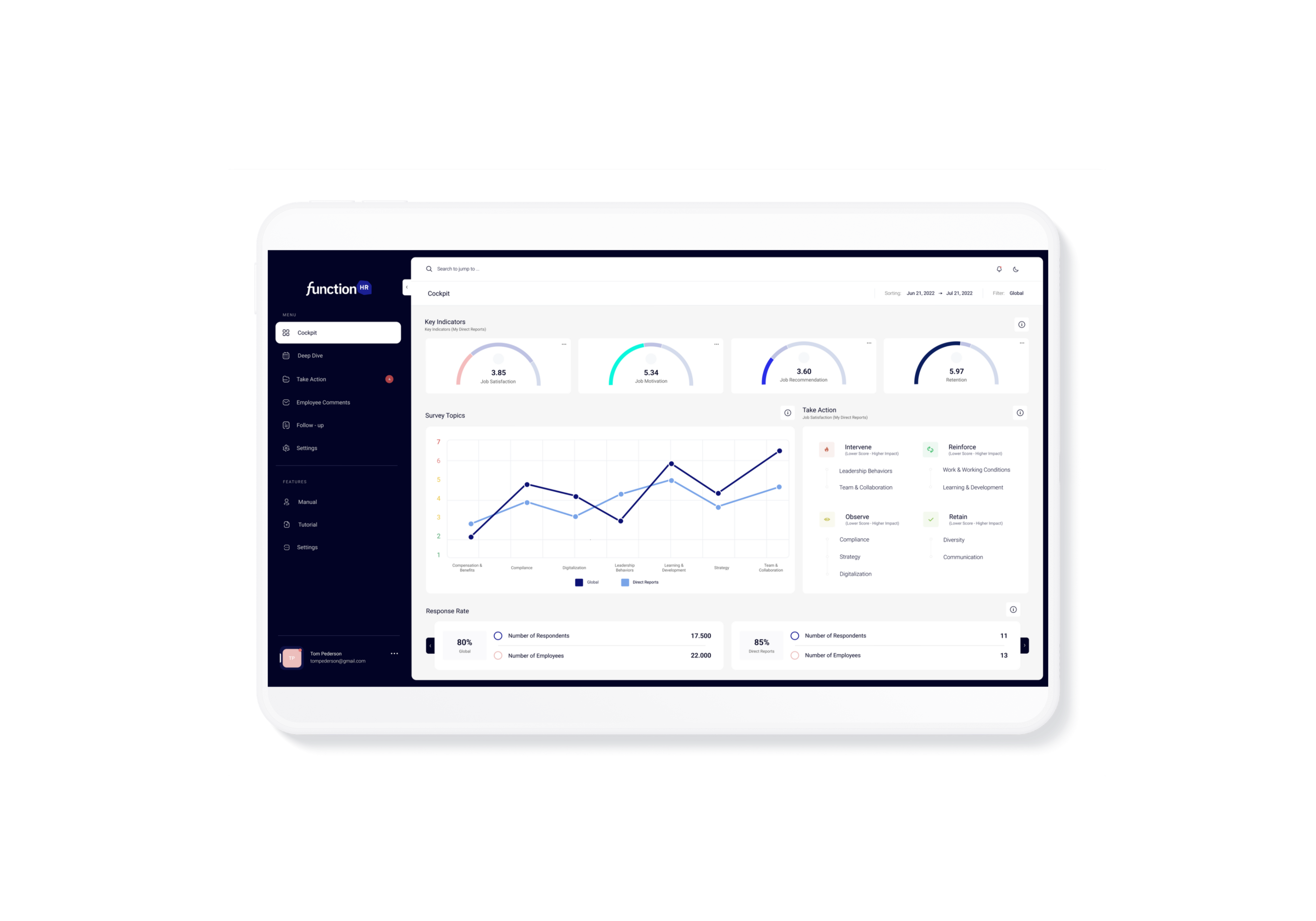
Whether you need modern HR reporting or advanced people analytics - functionHR's software solution makes it possible!
Features of modern People Analytics software
When selecting software, the general needs and requirements must be defined in advance. This is because providers for people analytics projects have different levels of expertise with regard to the features of their software solution and support throughout the entire project.
All-in-1 software solution for People Analytics
Collection, integration and processing of relevant data
• Digital personnel files
• HCM Systems
• Applicant Tracking System
• SAP
• Workday
• Oracle
• Personio
• PowerBI
• …
Anonymized employee surveys
Pulse Feedback
Historical survey data
…
Kununu
LinkedIn
Xing
Glassdoor
Monster
…
Excel Sheets
Google Analytics
Google Maps
HubSpot
…
Data analytics with powerful algorithms based on advanced statistics and artificial intelligence
Provision of results and implications for action in the interactive dashboard
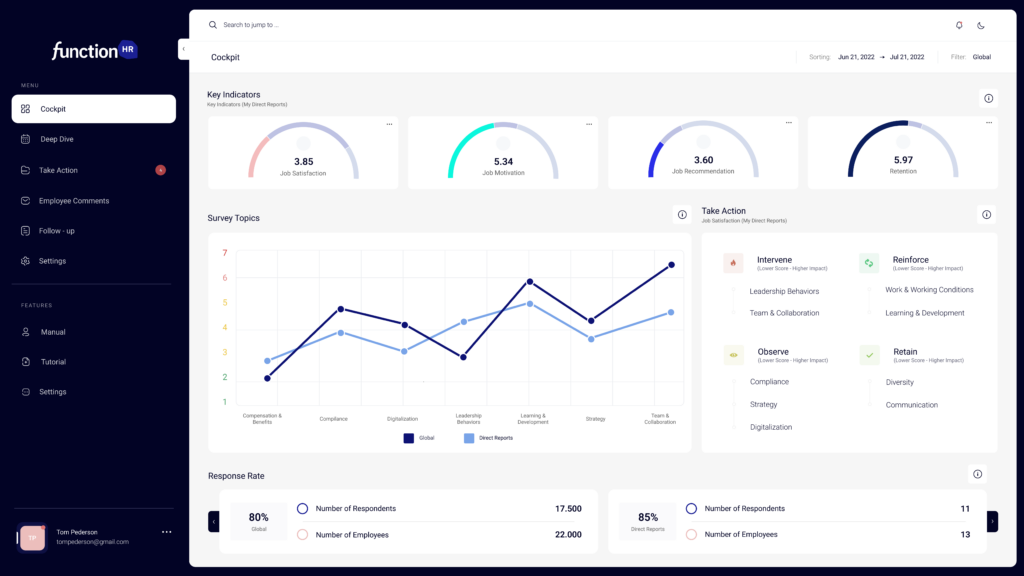
Follow-up process: selection and evaluation of suitable actions in the tool
This sounds too good to be true?
We would be happy to show you our award-winning people analytics software in a non-committal demo and guide you through this process.
Components of a holistic software solution
Collection and integration of HR data
With regard to data types, it is advisable to look for a software solution that also enables the collection of survey data. A fully integrated survey platform has clear benefits for data integration and analysis.
Providing results in interactive dashboards
To interpret the data and derive insights, the software vendor should provide a self-service dashboard. This dashboard contains visualizations of the data and enables drilling down with filter functions aligned to the organizational structure (e.g., job groups, locations, departments, …).
Solutions with built-in follow-up and change processes
Initiate & evaluate follow-up processes in the software
Data must be followed by action! It is particularly important that the findings from the evaluations are consistently implemented in follow-up processes. A stringent monitoring of the derived recommendations for action and defined initiatives with regard to the achievement of goals should be part of the holistic process of the people analytics project. Therefore, analytically supported follow-up processes should not only be initiated, but also mapped in the software. In this way, HR activities can be derived from the data in the software, selected in the tool, tracked and evaluated over time.
Features of a modern software solution
A professional provider covers all the necessary functionalities with a web-based software solution for performing HR data analytics and evaluating personal data:
Overview of relevant KPIs
Automated, AI-supported analysis of data in real time
Analysis of cause-effect relationships
Full integration of a survey platform with a selection of best-practice questionnaires from a broad question catalogue across different topics
Communication of results via role-specific dashboard views for all relevant user groups in the web-based, interactive HR Keyboard
Derivation of specific courses of action
Evaluation of actions and change processes
Modern, user-centered and CI-compliant design
Appealing visualization of data and results
Export and reporting functions (e.g. PDF reports)
Checkliste: Anbieterauswahl Mitarbeiterbefragungssoftware
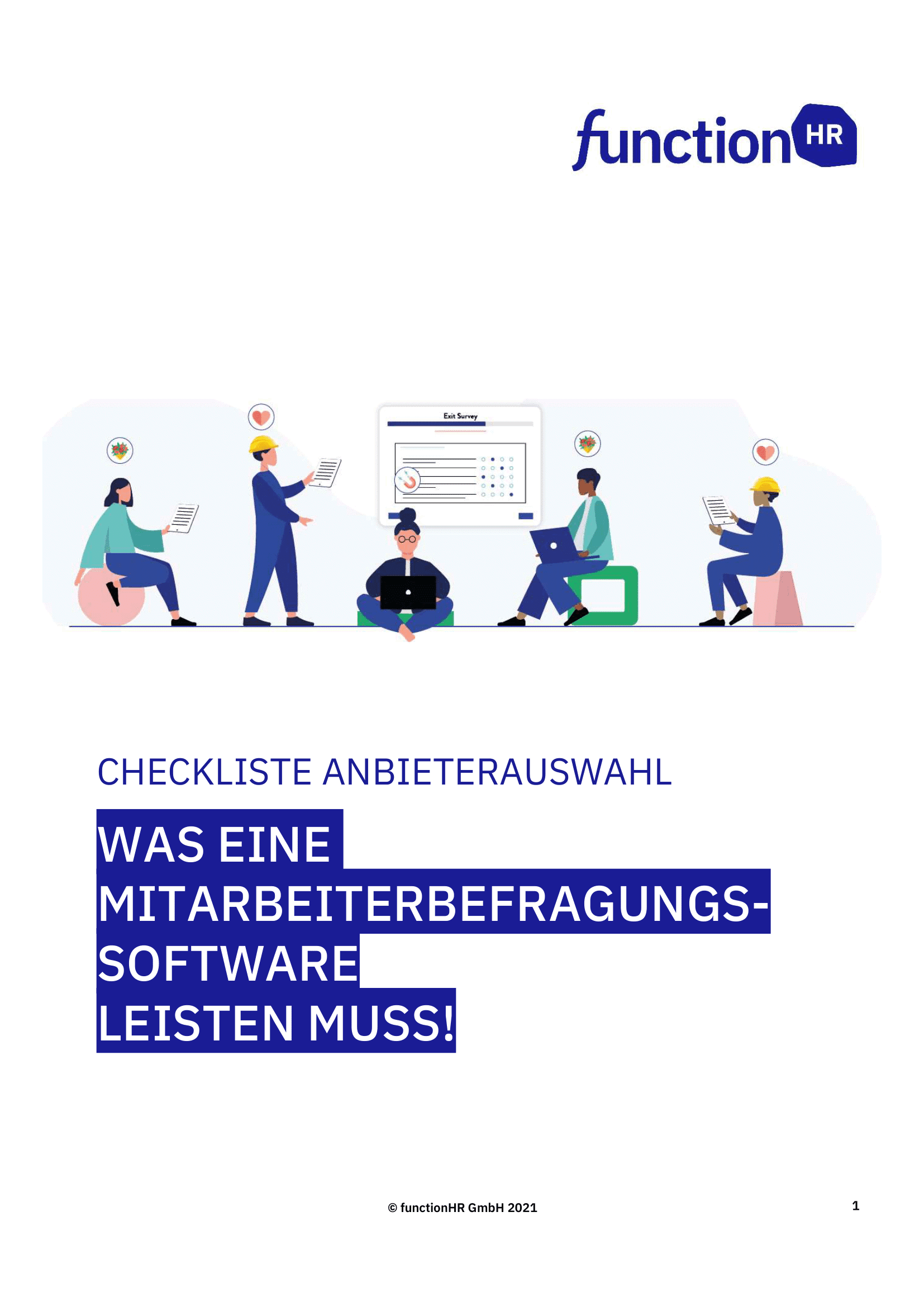
Fragebogenerstellung. Auswertung und Analyse. Maßnahmenplanung und Folgeprozess. Datenschutz. Eine Mitarbeiterbefragungssoftware muss einige Kriterien erfüllen. Diese Checkliste hilft Ihnen, Anbieter zu vergleichen und die für Sie passende Softwarelösung zu finden!
You are currently viewing a placeholder content from HubSpot. To access the actual content, click the button below. Please note that doing so will share data with third-party providers.
More InformationUsers and stakeholders of HR Analytics
People Analytics sheds light on the HR black box through systematic data analysis at multiple levels of the organization. AI-supported software reveals correlations between a measure and the corresponding reaction of the employees.
This allows questions from various stakeholders to be answered:
-
Top management
Top management benefits from a strategic analysis and can investigate specific questions about processes in the company, e.g: How can employee turnover be reduced?
-
Managers
Managers monitor their area of responsibility. Data-driven leadership makes it possible to adapt one's own leadership behavior to the needs and characteristics of one's area of responsibility. e.g.: How can I increase the performance of my team in the home office?
-
HR Business Partner
HR Business Partners monitor their area of responsibility, improve their decisions and take targeted actions, which they then evaluate in a data-driven approach. e.g.: What training is needed to develop individual leaders?
-
Recruiter
Recruiters optimize the application process, campaigns and KPIs & improve the candidate experience in the application process. e.g.: How can a vacancy be filled with the most suitable person?
-
People & Organization Developers
People & Organization Developers improve employee satisfaction, engagement and retention to reduce turnover. e.g.: What professional development opportunities increase training effectiveness and promote strategic workforce development?
-
Feelgood Managers
Employee experience experts proactively design a positive employee experience - for current and future employees. e.g.: What drivers influence a positive Employee Experience?
-
HR IT / HR Systems / Digitalization Managers
The interface of HR digitalization and HR IT digitalize HR processes and the strategic use of HR data. e.g.: How can repetitive administrative processes be identified, automated and thus made more efficient?
Data protection - a key factor for success
Personal data must be handled in accordance with strict data protection and data security guidelines. Of course, this also applies to people analytics and any data analysis in HR.
"Any information relating to an identified or identifiable natural person; an identifiable natural person is one who can be identified, directly or indirectly, in particular by reference to an identifier such as a name, an identification number, location data, an online identifier or one or more factors specific to that person."
Art. 4 GDPR
European requirements on data protection, data security and ethics
A number of laws define the data protection framework and limits for the data protection-compliant use of employee surveys.
EU General Data Protection Regulation (EU-GDPR)
German Federal Data Protection Act (BDSG)
Ethical principles
It goes without saying that the company’s data protection officers should be involved in the planning process from the very beginning. As professional experts, they can advise on planning and implementation with regard to the legal situation and data protection compliance. This includes, for example, the following aspects for the data protection-compliant implementation and evaluation of employee surveys:
Legally compliant declaration of consent by respondents for data processing
Anonymity and pseudonymization of data
Secure and encrypted data transmission
Data processing in accordance with applicable laws and guidelines
Transparency about analysis methods and algorithms used
Access controls
The solution for data privacy compliance – people analytics software from external providers
Data privacy issues can be a sensitive matter. It is advisable to outsource the implementation, evaluation, hosting of the data and reporting to external service providers. These providers are experts in data protection, legally compliant analysis and evaluation, as well as in communicating the results. The anonymity of the employees is therefore better protected.
However, there are also a number of things to consider when selecting external solutions. Especially since the transatlantic “Privacy Shield” data protection agreement was declared invalid on July 16, 2020. It regulated the transfer of personal data between the US and the EU. In the European area, this has a significant impact on the use and selection of external providers and their appropriate level of data protection in accordance with the GDPR.
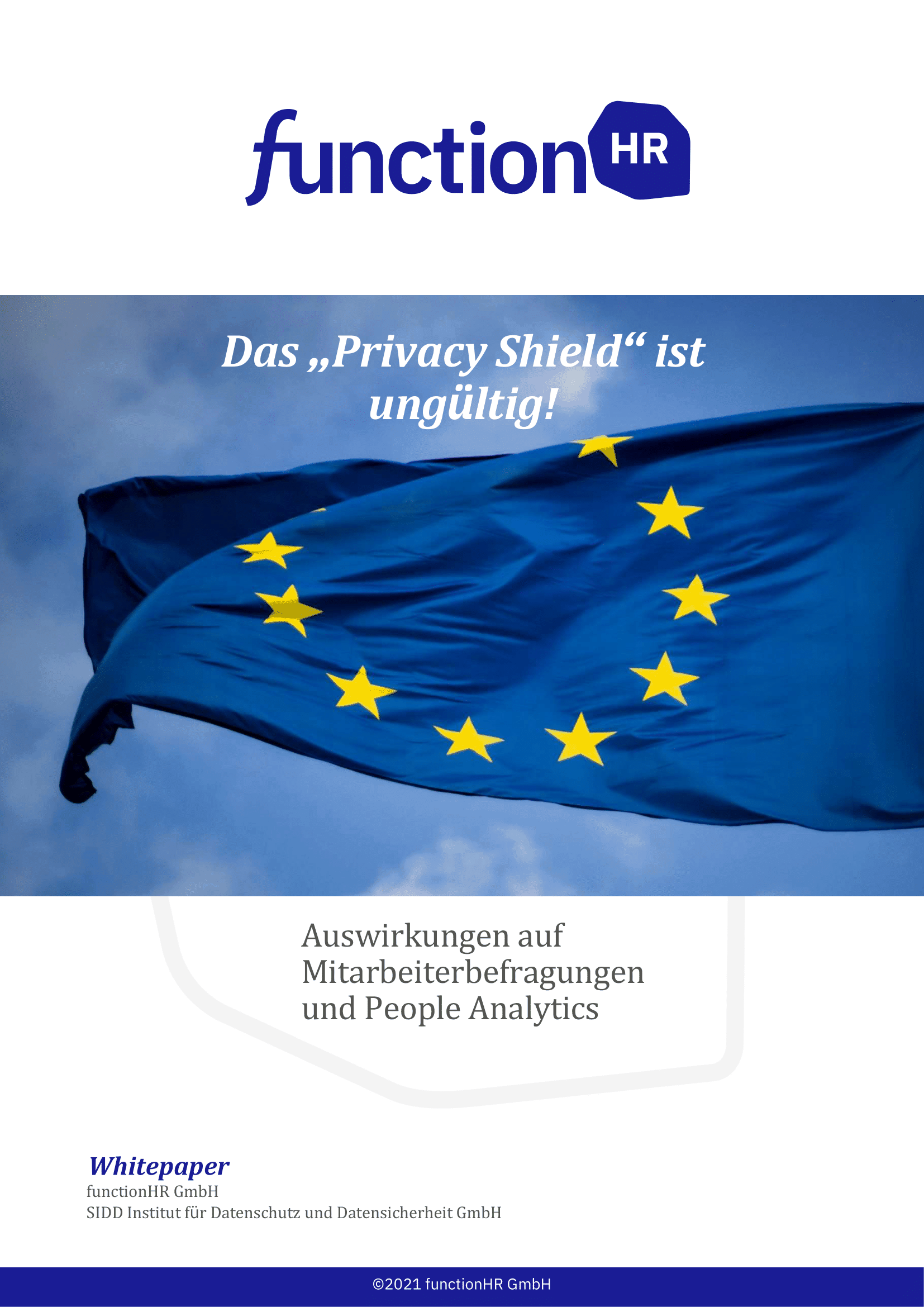
Der Europäische Gerichtshof (EuGH) hat das „Privacy Shield“ am 16. Juli 2020 für ungültig deklariert. In diesem Whitepaper klären wir über die Auswirkungen des Rechtsurteils auf den datenschutzkonformen Einsatz von Mitarbeiterbefragungen und People Analytics auf.
You are currently viewing a placeholder content from HubSpot. To access the actual content, click the button below. Please note that doing so will share data with third-party providers.
More InformationSuccess factors and costs for People Analytics projects
The key insight – in terms of ROI from a people analytics software solution – lies in the approach. The software is a means to an end. The actual benefit comes from the follow-up processes and the changes that are implemented. If you use people analytics to systematically evaluate existing data and/or feedback from employees and gain insight into the company, you know what needs to be done. However, this must then also be addressed and translated into actions. Unfortunately, the majority of people analytics projects fail because of this.
Typical use cases for HR data analytics relate to absenteeism, employee turnover, retention, satisfaction or motivation. If, for example, the analysis can prevent the turnover (and associated turnover costs) of just a few employees, the business case pays off quite quickly. The manufacturing company HAI, for example, has achieved savings in turnover costs in the 7-digit range in just one year with the help of surveys. The software has thus financed itself.
Make-or-buy decision
To start the people analytics journey, a make-or-buy decision must be made. A pilot project with a service provider makes it possible to implement a quick use case with manageable effort (data, costs, time) and to reap initial rewards. As a rule, it is easier to successfully establish people analytics in the company if it is started with a convincing and verifiable success. Once the support of the relevant stakeholders has been gained, an easily scalable people analytics platform can then be built.
Industry Insights: How data-driven people management adds measurable value to business success
Goals | People Analytics Platform |
|---|---|
|
|
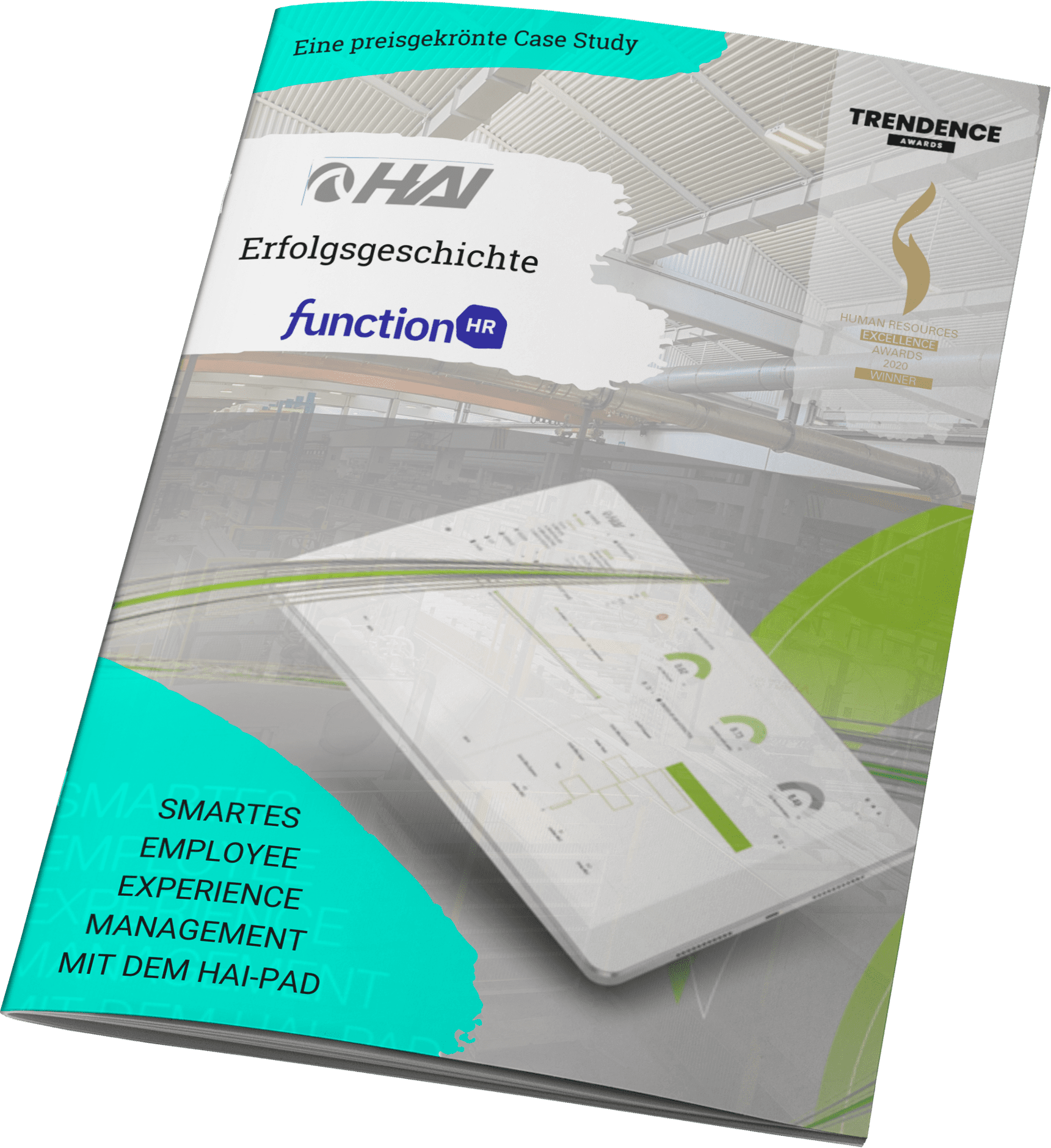
HAI Success Story
Hammerer Aluminium Industries was able to reduce early turnover by 45% and overall turnover by 25% within one year through the use of data analytics, saving over €1 million in turnover costs and improving their Net Promoter Score by 14 points.
Would you like to get to know our people analytics software better?
Use your data and gain valuable insights for better HR work across all HR areas.
Passende Beiträge in unserem Blog:
Kostenfreie Downloads für Sie:
HR Reporting - Einführung in die Welt der Kennzahlen und KPIs
You are currently viewing a placeholder content from HubSpot. To access the actual content, click the button below. Please note that doing so will share data with third-party providers.
More InformationSteigen Sie ein in das moderne HR Reporting als erster People Analytics Use Case.


